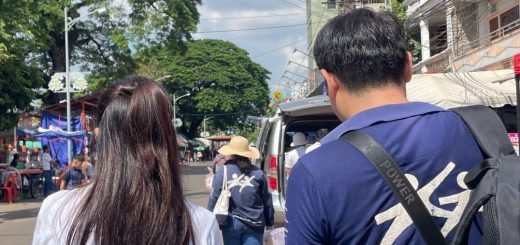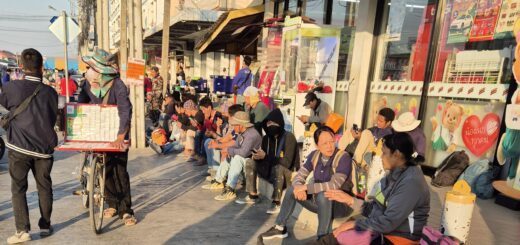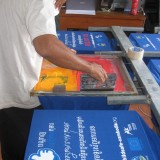From the outskirts of Phnom Penh to the garbage site of Siem Reap – in the field with Mith Samlanh and Kaliyan Mith
As part of the 3PC Partnership Programme for the Protection of Children, Friends-International works together with nine civil society organizations (CSOs) in five provinces in Cambodia to strengthen child protection systems through capacity building and coordination with and contributions to national and sub-national child protection responses in Cambodia. Wanchi – 3PC Child Protection Researcher at Friends-International – travelled through five provinces in Cambodia to conduct research on child rights, child protection and child abuse, the outcomes of which will feed into the further development of the 3PC Programme. Mith Samlanh and Kaliyan Mith are partner CSOs in the 3PC Programme and in this post, Wanchi writes about her experience of joining them in the field to conduct surveys with their beneficiaries and the community members in Phnom Penh and Siem Reap.
I joined Friends-International in May in order to conduct research for the 3PC Programme. When I was told that there would be some travel involved, I was delighted! Of course I was happy to work in the field, directly with our partner CSOs in the provinces.
I developed two different surveys: one for all nine 3PC CSO partner beneficiaries (children aged 7-24) and another for adult community members in Phnom Penh (with Mith Samlanh) and Siem Reap (with Kaliyan Mith). Both aimed to measure the level of knowledge, attitude and practices regarding child rights and child protection. With the help from the Khmer staff at the partner CSOs, these surveys were conducted in Khmer.
I started my research trip with Mith Samlanh in Phnom Penh. After training the surveying team, we went to conduct the surveys with the children and youth in the drop in centers in Olympic Zone, Chabar Ampou and Andong. The children and youth come here to hang out and play, learn about sanitation and hygiene, wash and talk about problems etc. They were also happy to help us with our research and answered our survey attentively.
After three days spent working in these areas we then visited local communities in which Mith Samlanh works with marginalized children. Many of the respondents of our adult community member survey were adults who are connected to Mith Samlanh as their children are beneficiaries of the program – some of whom are part of the home-based production projects. While being in these communities, I felt as if I was in a different world – far away from the Phnom Penh that I know. The living standards are very poor and in significant contrast to the city center, even though we were less than 10km away. Houses are often temporary establishments made of wood and corrugated iron lacking basic sanitation and hygiene. Water is collected from the river or from rain water and children drink straight from the buckets.
The week after surveying with Mith Samlanh I travelled to Siem Reap to conduct the same surveys with Kaliyan Mith. After training the surveying team, we conducted surveys with street living/working children and children in schools. Kaliyan Mith works with and knows all of these children through their outreach work.
In order to reach more street-living children, we conducted surveys during the evenings. Some of the children were very young, scavenging for a living and sleeping in the parks. Some of the youth have lived this way for a long time – they sleep in parks or pagodas and meet the parks at night.
While conducting the surveys with these children and youth, an elderly woman approached us with her little boy. She told us her husband had a new girlfriend and after abusing her, he kicked her and their son out of their home. Our Kaliyan Mith social worker from the surveying team was quick to respond. He reported the situation to the coordinator and took the woman and her son to Kaliyan Mith’s transitional home where they received food, shelter and care, whilst looking for solutions to her problems.
The next three days, we went to the communities of Chong K’Neas, Mondul Bai and Anlong Pi on our Kaliyan Mith motorbikes. Most areas were far away from Siem Reap city center and sometimes they were harder to reach on the sandy and muddy roads.
I realized that many communities were similar. People were friendly towards us and very happy to help with anything. At the same time, there is a lot of poverty, alcohol abuse with very low sanitation and hygiene standards.
We talked to community members, parents of Kaliyan Mith beneficiaries and village chiefs in order to assess what they know about child abuse, what they think of abusive practices and whether abuse happens in their community (and if so, what kind). We visited the respondents in their homes in each of the communities. In Chong K’Neas and Mondul Bai, most of the respondents were unemployed or working in food or agriculture.
Anlong Pi was perhaps the strangest place I have ever spent a full day. This was the garbage site outside of Siem Reap. You could smell the site and burning garbage from a distance. People living in this area are mostly scavengers, as too are their children. It can go without saying that the living conditions in this community were extremely poor. While conducting the survey on child protection and child abuse, many adults did not even realize that their children scavenging is a form of exploitation – and therefore abuse.
During the trip I gathered a lot of useful data – and visited many other NGOs and communities on the way. Every day was a different experience and often an adventure. The research will help determine the future programmes and activities for the 3PC Programme. For Mith Samlanh and Kaliyan Mith, this also means working towards creating a ChildSafe network in these marginalized communities and gaining more ChildSafe members from local community members.
‘Together, building futures’ for stronger child protection systems across Cambodia.












1 Response
[…] […]